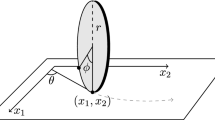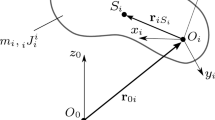Abstract
The aim of this paper is to apply the nonlinear superposition principle to some non-holonomic systems, in particular, those in chained and power forms, which are used to represent the kinematic equations of various non-holonomic wheeled vehicles. The existence of nonlinear superposition formulas is studied on the basis of Lie algebraic analysis. First, it is shown that nonlinear superposition formulas can be constructed using the knowledge of n + 1 particular solutions, using the affine structure of a system in chained form and the fact that a system in power form is diffeomorphic to a system in chained form. Secondly, using the notion of first integral, it is shown that only one particular solution is sufficient.
Similar content being viewed by others
References
Anderson R, Harnad J, Winternitz P. Systems of ordinary differential equations with nonlinear superposition principles. Phys D: Nonlinear Phenom. 1982;4(2):164–82.
Angelo RM, Duzzioni EI, Ribeiro AD. Integrability in time-dependent systems with one degree of freedom. J Phys A: Math Theor. 2012;45(5):055101.
Blázquez-Sanz D, Morales-Ruiz JJ. Local and global aspects of lie superposition theorem. J Lie Theor. 2010;20(3):483–517.
Cariñena JF, Clemente-Gallardo J, Ramos A. Motion on Lie groups and its applications in control theory. Rep Math Phys. 2003;51(2):159–70.
Cariñena JF, de Lucas J. Lie systems: theory, generalisations, and applications. Diss Math. 2012;479:1–162.
Cariñena JF, Grabowski J, de Lucas J. Superposition rules for higher order systems and their applications. J Phys A: Math Theor. 2012;45(18):185202.
Cariñena JF, Grabowski J, Marmo G. 2000. Lie-Scheffers systems: a geometric approach. Bibliopolis Napoli.
Cariñena JF, Grabowski J, Marmo G. Superposition rules, Lie theorem, and partial differential equations. Rep Math Phys. 2007;60(2):237–58.
Cariñena JF, Guha P, de Lucas J. A quasi-lie schemes approach to second-order gambier equations. SIGMA 2013;9:026.
Conte G, Moog CH, Perdon AM. Algebraic methods for nonlinear control systems. Communications and control engineering, 2nd ed. London: Springer; 2006.
Fleming WH. Functions of several variables.3rd ed. New York: Springer; 1987.
Grabowski J, de Lucas J. Mixed superposition rules and the Riccati hierarchy. J Differ Equ. 2013;254(1):179–98.
Ibragimov NH. Elementary Lie group analysis and ordinary differential equations. New York: Wiley; 1999.
Ibragimov NH. Integration of systems of first-order equations admitting nonlinear superposition. J Nonlinear Math Phys. 2009;16(supp01):137–47.
Lie S, Scheffers GW. Vorlesungen uber continuierliche Gruppen mit geometrischen und anderen Anwendungen. Leipzig: Teubner; 1893.
M’Closkey, RT, Murray, RM. Convergence rates for nonholonomic systems in power form. In: American control conference, 1993. IEEE; 1993. p. 2967–2972.
Menini L, Tornambè A. Linearization of Hamiltonian systems through state immersion. In: Proceedings of the 47th IEEE conference on decision and control; 2008. p. 1261–6.
Menini L, Tornambè A. On the use of semi-invariants for the stability analysis of planar systems. In: Proceedings of the 47th IEEE conference on decision and controlp; 2008. 634–9.
Menini L, Tornambè A. Linearization through state immersion of nonlinear systems admitting Lie symmetries. Automatica 2009;45(8):1873–8.
Menini L, Tornambè A. On the generation of classes of planar systems with given orbital symmetries. In: Proceedings of the 48th IEEE conference on decision and control; 2009. p. 7442–7.
Menini L, Tornambè A. A procedure for the computation of semi-invariants. In: Proceedings of the 48th IEEE Conference on Decision and Control; 2009. p. 7460–5.
Menini L, Tornambè A. Computation of a linearizing diffeomorphism by quadrature. In: Proceedings of the 49th IEEE conference on decision and control; 2010. p. 6281–6.
Menini L, Tornambè A. Linearization of discrete-time nonlinear systems through state immersion and Lie symmetries. In: Proceedings of the NOLCOS 2010. Bologna; 2010. p. 197–202.
Menini L, Tornambè A. Semi-invariants and their use for stability analysis of planar systems. Int J Control 2010;83(1):154–181.
Menini L, Tornambè A. Stability analysis of planar systems with nilpotent (non-zero) linear part. Automatica 2010;46(3):537–542.
Menini, L., Tornambè, A. Nonlinear superposition formulas: some physically motivated examples. In: Decision and Control and European Control Conference (CDC-ECC), 2011 50th IEEE Conference on; 2011. p. 1092–7.
Menini L, Tornambè A. Symmetries and semi-invariants in the analysis of nonlinear systems. London: Springer; 2011.
Murray RM, Sastry SS. Nonholonomic motion planning: steering using sinusoids. IEEE Trans Autom Control 1993;38(5):700–16.
Olver PJ. Applications of Lie groups to differential equations, volume 107 of Graduate Texts in Mathematics. New York: Springer; 1986.
Pietrzkowski G. Explicit solutions of the 𝔞1-type Lie-Scheffers system and a general Riccati equation. J Dyn Control Syst. 2012;18(4):551–71.
Samson C. Control of chained systems application to path following and time-varying point-stabilization of mobile robots. IEEE Trans Autom Control 1995;40(1):64–77.
Sordalen, OJ. Conversion of the kinematics of a car with n trailers into a chained form. In: In: Proceedings of the 1993 IEEE international conference on robotics and automation 1993, IEEE; 1993. p. 382–7.
Sorine M, Winternitz P. Superposition laws for solutions of differential matrix Riccati equations arising in control theory. IEEE Trans Autom Control 1985;30(3):266–72.
Stephani H. Differential equations: their solutions using symmetries. Cambridge: Cambridge University Press; 1989.
Teel, AR, Murray, RM, Walsh, G. Nonholonomic control systems: from steering to stabilization with sinusoids. In: Proceedings of the 31st IEEE conference on decision and control 1992, IEEE; 1992. p. 1603–9.
Tilbury, D, Laumond, JP, Murray, R, Sastry, S, Walsh, G. Steering car-like systems with trailers using sinusoids. In: Proceedings of the 1992 IEEE international conference on robotic and automation 1992, IEEE; 1992. p. 1993–8.
Winternitz, P. Lie groups and solutions of nonlinear differential equations. In: Nonlinear phenomena. Springer; 1983. p. 263–331.
Author information
Authors and Affiliations
Corresponding author
Rights and permissions
About this article
Cite this article
Menini, L., Tornambè, A. Nonlinear Superposition Formulas for Two Classes of Non-holonomic Systems. J Dyn Control Syst 20, 365–382 (2014). https://doi.org/10.1007/s10883-014-9225-8
Received:
Revised:
Published:
Issue Date:
DOI: https://doi.org/10.1007/s10883-014-9225-8




